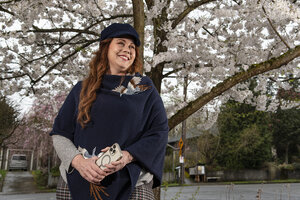Meeting addiction with compassion
It can be tempting to despair at the seeming intractability of drug problems worldwide. What doesn't make the news nearly enough are everyday examples of individuals freeing themselves from addiction.

Activist and independent journalist Angela Todd poses for a portrait in Portland, Oregon, March 25, 2024.
Alfredo Sosa/Staff
She didn’t ask for money, though it was clear she was homeless. She didn’t ask for food, either. Her simple request was, “Can I have a hug?”
The encounter took place while I was interviewing independent journalist and activist Angela Todd in downtown Portland, Oregon. Ms. Todd chronicles the city’s overlapping drug and homelessness crises on her @PDXreal social media accounts. We met the displaced woman, Karen, outside a theater. It was raining. Several people, hunched over phones and heroin pipes, were sheltered under the marquee. Karen declined to share her last name, but less than a minute after she and Ms. Todd met, they were exchanging a teary embrace.
I thought about that hug – two hearts pressed together – while reading the cover story package in the Aug. 5 issue of The Christian Science Monitor Weekly. It’s a three-part series about potential solutions to addiction. I traveled to Portland to follow up on a cover story that my colleague Story Hinckley reported last year about Oregon’s evolving efforts to combat addiction. Another colleague, Sara Miller Llana, ventured into rural British Columbia to meet mothers advocating for safer drugs. And in Lisbon, special correspondent Dominique Soguel examined Portugal’s drug decriminalization program. The thread that links all three stories is compassion. As you read about ideological debates over the most effective public policies, you’ll also meet remarkable individuals helping those struggling with addiction.
Which brings me back to that hug. In Portland and other cities, people living on the street are accustomed to the embarrassed expressions of passersby. The avoidance of eye contact can make it feel as if they’re living in exile. After Ms. Todd gave her contact information to Karen, the activist told me, “The work is not in the ideology. The work is actually connecting with people and being in community.”
It can be tempting to despair at the scope and seeming intractability of drug problems worldwide. What doesn’t make the news nearly enough are everyday examples of individuals freeing themselves from addiction. This Monitor series includes numerous success stories, underscoring the powerful role that individuals and societal institutions can play. Drug treatment provider Joe Bazeghi told me what a difference it makes when those in rehab feel the support of someone who believes in them.
“When they have people in their church, or in their family, or friends, or at their social clubs, whatever it may be ... that works for a lot of folks,” says Mr. Bazeghi. “That’s an indicator of success.”
Our cover story package also provides a window into the endeavors of drug treatment providers. It’s not glamorous work. When those addicted to drugs feel alone and unworthy, treatment providers respond with a different message.
“At its core is ‘I love you, even if you use drugs,’” says Tera Hurst, executive director of the Health Justice Recovery Alliance in Oregon. “There is this unconditional love for the person. They see the person as a person and not as a sum of their very worst moments.”

